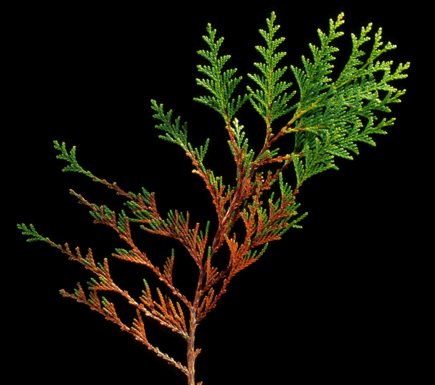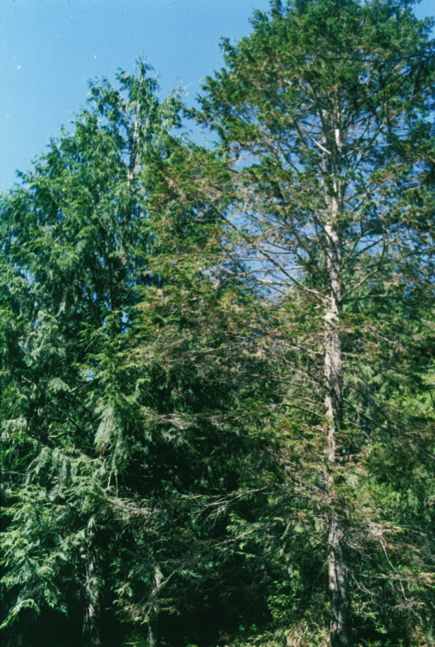PESTS AND DISEASES OF FORESTRY IN NEW ZEALAND
Leaf spot caused by Stigmina thujina
Scion is the leading provider of forest-related knowledge in New Zealand
Formerly known as the Forest Research Institute, Scion has been a leader in research relating to forest health for over 50 years. The Rotorua-based Crown Research Institute continues to provide science that will protect all forests from damage caused by insect pests, pathogens and weeds. The information presented below arises from these research activities.
From Scion publication Forest Research Bulletin 220, An Introduction to The Diseases of Forest and Amenity Trees in New Zealand.
G.S.Ridley and M.A. Dick 2001
Species: Stigmina thujina (Ascomycete anamorph)
Common name: None
Country of origin: Pacific Northwest of North America
Host(s): Chamaecyparis lawsoniana, C. pisifera, C. obtusa, Cupressus sp., Thuja plicata.
Symptoms: Infection commonly occurs on leaves but has been found on small twigs, leading to dieback. Older foliage, nearest the main stem, is affected first and susceptible trees may retain only an outer rim of green (Fig. 33). Dark-brown fruit-bodies occur on necrotic areas of leaves and twigs.
Disease development: Not known.
NZ distribution: Stigmina thujina is found in the central North Island, Canterbury, Nelson, and the West Coast.
Economic impact: In most locations the disease is of little consequence, but severe defoliation of C. lawsoniana in some plantations has led to a policy of replanting with other species (Fig. 34).
Control: None available.

Fig. 33: Foliage of Chamaecyparis lawsoniana infected by Stigmina thujina

Fig. 34: Compare the Chamaecyparis lawsoniana (right) defoliated by Stigmina thujina with the unaffected Thuja plicata (left)
History: The earliest New Zealand record of Stigmina thujina, held at the New Zealand Forest Research Institute, is from 1963 when it was identified on C. lawsoniana from Queens Gardens in Nelson. There is one overseas report of serious defoliation of C. lawsoniana in association with S. thujina infection. In 1982 needle blight of planted C. lawsoniana was reported on several islands in Hawaii. Within a group of trees, disease severity ranged from no symptoms to complete defoliation and death. It was concluded that differences in individual tree susceptibility were responsible for the variation in symptoms, as in several groups healthy trees were next to those which were heavily defoliated. The symptoms described in Hawaii are identical to those observed in New Zealand. Chamaecyparis lawsoniana originates from coastal North America, as apparently the fungus does also, but there are no reports of defoliation associated with S. thujina from that part of the world. Although pathogenicity tests have not been carried out on C. lawsoniana, either here or in Hawaii, observations over many years show a consistent association of this fungus with a particular set of symptoms, strongly suggesting a cause and effect relationship.
References: Bradbury 1997; Dick 1997; Funk 1985; Hodges 1982
This information is intended for general interest only. It is not intended to be a substitute for specific specialist advice on any matter and should not be relied on for that purpose. Scion will not be liable for any direct, indirect, incidental, special, consequential or exemplary damages, loss of profits, or any other intangible losses that result from using the information provided on this site.
(Scion is the trading name of the New Zealand Forest Research Institute Limited.)

 Farm Forestry New Zealand
Farm Forestry New Zealand

